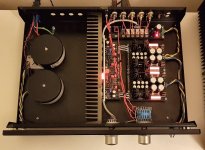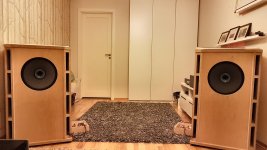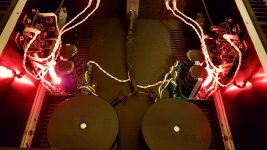Perfect... will let you know my listening impressions.
As for now, I doubted that the DCB1 could be improved upon but this one has guts, detail, extension.... outstanding.
As for now, I doubted that the DCB1 could be improved upon but this one has guts, detail, extension.... outstanding.
The 598 will be most at home with classical, Jazz, acoustic. If you want it for more vigorous genres somewhat better compatibility weigh again vs those 880 Beyers.
DCG3 seems taking the test of time well with others, I met with one of my most peculiar first tester friends recently and he maintains his original enthusiastic impressions after almost a year of use. No failures also.
DCG3 seems taking the test of time well with others, I met with one of my most peculiar first tester friends recently and he maintains his original enthusiastic impressions after almost a year of use. No failures also.
My DCG3bal build now has well over 125hrs of run time on it so I thought I would like to share my listening impressions compared to my BA3bal.
The Ba3b has two Salas SLV1.1 pairs of regs which I progressively hotrodded. This made a tremendous improvement in the sense of space and dynamics and I was very pleased with the sound.
When I plugged the DCG3b into my system I was initially quite overwhelmed by the “right in my face” presentation of the DCG3b. The BA3b sounded smooth and laid back and the DCG3b sounded as if the performers had consumed a bit too much coffee and for a certain volume level the detail and bass sounded a bit unrealistic to me.
Then it occurred to me that I should adjust the position of my speakers and the DCG3b really started shining. Took me about a week of fiddling but now I got the depth of the performance where I want it and everything has clicked into place.
What an expansive, detailed and full bodied sound! I have heard some very expensive preamps where the emphasis is on detail and crazy low distortion/noise numbers but the sound is dry and sterile. Not so here. The balance of fundamental and harmonics seems just right. It sounds slightly wider and bigger in presentation than my BA3b but with a lot greater detail. The DCG3b gives a more energetic performance as it highlights the ebb and flow of the music. Now in comparison when I play the BA3b I feel that the performance sounds a bit sleepy.
I double checked myself by attending two classical performances both in a relatively small hall and my honest compliment is that the DCG3b sounds correct! Bravo!
So what is it about the design that gives this outstanding detail? Is it the combination of CCS current control and cascode voltage control of M1 that does the trick? Is the DCSTB making its own special contribution?
nash
The Ba3b has two Salas SLV1.1 pairs of regs which I progressively hotrodded. This made a tremendous improvement in the sense of space and dynamics and I was very pleased with the sound.
When I plugged the DCG3b into my system I was initially quite overwhelmed by the “right in my face” presentation of the DCG3b. The BA3b sounded smooth and laid back and the DCG3b sounded as if the performers had consumed a bit too much coffee and for a certain volume level the detail and bass sounded a bit unrealistic to me.
Then it occurred to me that I should adjust the position of my speakers and the DCG3b really started shining. Took me about a week of fiddling but now I got the depth of the performance where I want it and everything has clicked into place.
What an expansive, detailed and full bodied sound! I have heard some very expensive preamps where the emphasis is on detail and crazy low distortion/noise numbers but the sound is dry and sterile. Not so here. The balance of fundamental and harmonics seems just right. It sounds slightly wider and bigger in presentation than my BA3b but with a lot greater detail. The DCG3b gives a more energetic performance as it highlights the ebb and flow of the music. Now in comparison when I play the BA3b I feel that the performance sounds a bit sleepy.
I double checked myself by attending two classical performances both in a relatively small hall and my honest compliment is that the DCG3b sounds correct! Bravo!
So what is it about the design that gives this outstanding detail? Is it the combination of CCS current control and cascode voltage control of M1 that does the trick? Is the DCSTB making its own special contribution?
nash
Simplest circuit possible for set goals with various topology experimental breadboarding, no role model other design mind bias just mixing basic principles, field effect transistors practical research for which perform best together for the particular final circuit, much bench experimentation for best values on measurements, time consuming repetative layout effort, much listening experimentation to the dcg3/dcstb system as a whole, extensive beta testing period. So I would say that the "trick" is the whole thing from inception to finalization.
Simplest circuit possible for set goals with various topology experimental breadboarding, no role model other design mind bias just mixing basic principles, field effect transistors practical research for which perform best together for the particular final circuit, much bench experimentation for best values on measurements, time consuming repetative layout effort, much listening experimentation to the dcg3/dcstb system as a whole, extensive beta testing period. So I would say that the "trick" is the whole thing from inception to finalization.
Appreciated Salas... Share the same experiance as nashbap!
Jesper.
Guys, I think you need to have a mercy towards idiots like me who did not acquire DCG3 PCB on time. They are out of stock for quite a while and Tea is saying that new orders must to wait till some critical mass will be reached. I already reached my own critical mass and it is very hard to wait…🙂. Is anyone who purchased PCB/KIT/PSU/KIT is decided not to make it – please let me know. Very-very interested in it!!!
Thank you.
Thank you.
The 598 will be most at home with classical, Jazz, acoustic. If you want it for more vigorous genres somewhat better compatibility weigh again vs those 880 Beyers.
DCG3 seems taking the test of time well with others, I met with one of my most peculiar first tester friends recently and he maintains his original enthusiastic impressions after almost a year of use. No failures also.
The 598 has 23ohm imp while the 880 are near 250ohm.... does it mean the 880 will sound louder for the same volume input ?
The 598 has 23ohm imp while the 880 are near 250ohm.... does it mean the 880 will sound louder for the same volume input ?
The 598 (open back, cream/brown) has 50 Ohm, the 598SE special edition package (open back, black) has 50 Ohm, the 598CS (closed back version, less distinct overall but with more bass, isolates enough, black) has 23 Ohm.
The open backs are 112dB/V the closed back is 115db/V. Very sensitive headphones, as much as DJ types sensitive. Can play loud directly from mobile phones. Renowned consumer models, all plastic construction, very comfortable to wear.
The DT 880 250 Ohm has 96dB/mW = 102dB/V middle of the road sensitivity still easy to drive with an amp, quieter on mobile phones. Better electrical damping, asks less current swing. 100mA DCG3 bias is plenty for easy load THD on those. Renowned professional studio model, robust construction (metal headband, all parts user serviceable), big comfy cushions, still much comfortable to wear but stays firmer on the head.
The 598 (open back, cream/brown) has 50 Ohm, the 598SE special edition package (open back, black) has 50 Ohm, the 598CS (closed back version, less distinct overall but with more bass, isolates enough, black) has 23 Ohm.
The open backs are 112dB/V the closed back is 115db/V. Very sensitive headphones, as much as DJ types sensitive. Can play loud directly from mobile phones. Renowned consumer models, all plastic construction, very comfortable to wear.
The DT 880 250 Ohm has 96dB/mW = 102dB/V middle of the road sensitivity still easy to drive with an amp, quieter on mobile phones. Better electrical damping, asks less current swing. 100mA DCG3 bias is plenty for easy load THD on those. Renowned professional studio model, robust construction (metal headband, all parts user serviceable), big comfy cushions, still much comfortable to wear but stays firmer on the head.
Thank you very much.
Maybe the 880 are best value
Looks very nice and tidy your build. Did you manage as hum & buzz free in the main system for multi-input line duty as it was quiet on headphones when you first tested it?
Yes. It is dead silent. No hum, buzz or whatever both with headphones and main speakers. My speakers are approx 96dB sensitive. If I put my ear deep inside the tweeter horn I can barely hear something. 5cm away - nothing. Its practicly inaudible.
Poweramp is "Ovation-sx" 15W class A from Bonzai.
Dac is Soekris dam1021 - "modified" with own designed filters.
Poweramp is "Ovation-sx" 15W class A from Bonzai.
Dac is Soekris dam1021 - "modified" with own designed filters.
Last edited:
Good amp. Bonsai knows his stuff. And a good source. Must be a sweet total system. Congrats and enjoy.
BTW is that red twisted pair wiring single strand OFC or something, and are the speakers DIY also?
BTW is that red twisted pair wiring single strand OFC or something, and are the speakers DIY also?
The wires are some ofc copper/silver ptfe insulated stuff.
I think you have seen the speakers before 🙂 - have a small room in the basement..
Two of a kind on planet earth ;-) diy of course
One inside pic of the poweramp also.

I think you have seen the speakers before 🙂 - have a small room in the basement..
Two of a kind on planet earth ;-) diy of course
One inside pic of the poweramp also.

Attachments
Last edited:
Simplest circuit possible for set goals with various topology experimental breadboarding, no role model other design mind bias just mixing basic principles, field effect transistors practical research for which perform best together for the particular final circuit, much bench experimentation for best values on measurements, time consuming repetative layout effort, much listening experimentation to the dcg3/dcstb system as a whole, extensive beta testing period. So I would say that the "trick" is the whole thing from inception to finalization.
Thanks Salas.
I am having some difficulty understanding how the Vgs at M1 is arrived at. I understand how the divider network of R9 and R8 gives the Vgs for M2. I also understand how M3 produces the constant current. I measure Vgs at M1 at 4.36VDC and for M2 around 4.4VDC.
nash
@bambadoo
They maybe also remind me of the big white cabinet large format coaxial ones that Stajo of Sweden had shown once in the tube threads, but I am not very sure.
Such speakers can be very dynamic and musical. Reminding the legendary big Tannoy approach, that is the nearest commercial thing most people must have come across in some audio shows.
They maybe also remind me of the big white cabinet large format coaxial ones that Stajo of Sweden had shown once in the tube threads, but I am not very sure.
Such speakers can be very dynamic and musical. Reminding the legendary big Tannoy approach, that is the nearest commercial thing most people must have come across in some audio shows.
Thanks Salas.
I am having some difficulty understanding how the Vgs at M1 is arrived at. I understand how the divider network of R9 and R8 gives the Vgs for M2. I also understand how M3 produces the constant current. I measure Vgs at M1 at 4.36VDC and for M2 around 4.4VDC.
nash
Hi Nash,
The constant current forces M1 open and its Vgs develops
Hi Nash,
The constant current forces M1 open and its Vgs develops
Wow I never knew that. Thanks.
nash
- Home
- Source & Line
- Analog Line Level
- Salas DCG3 preamp (line & headphone)


